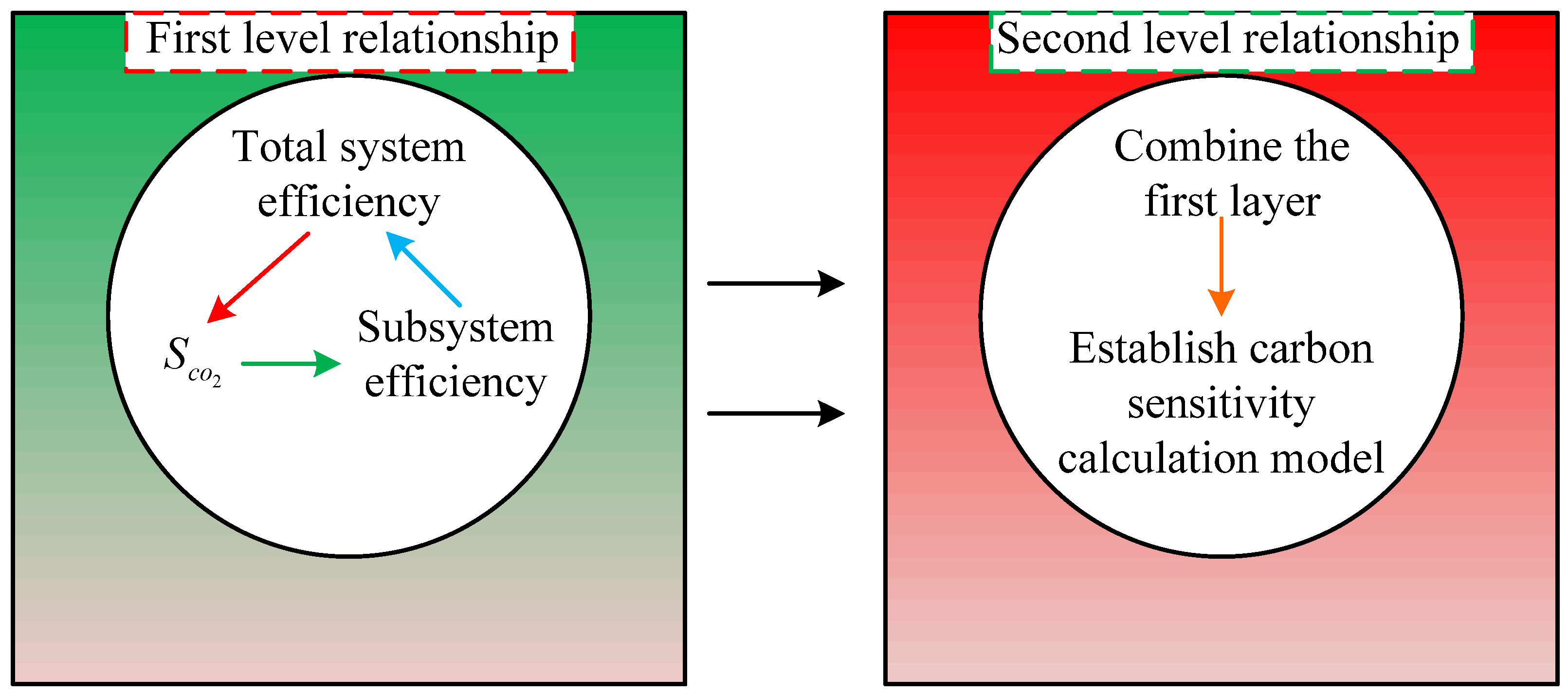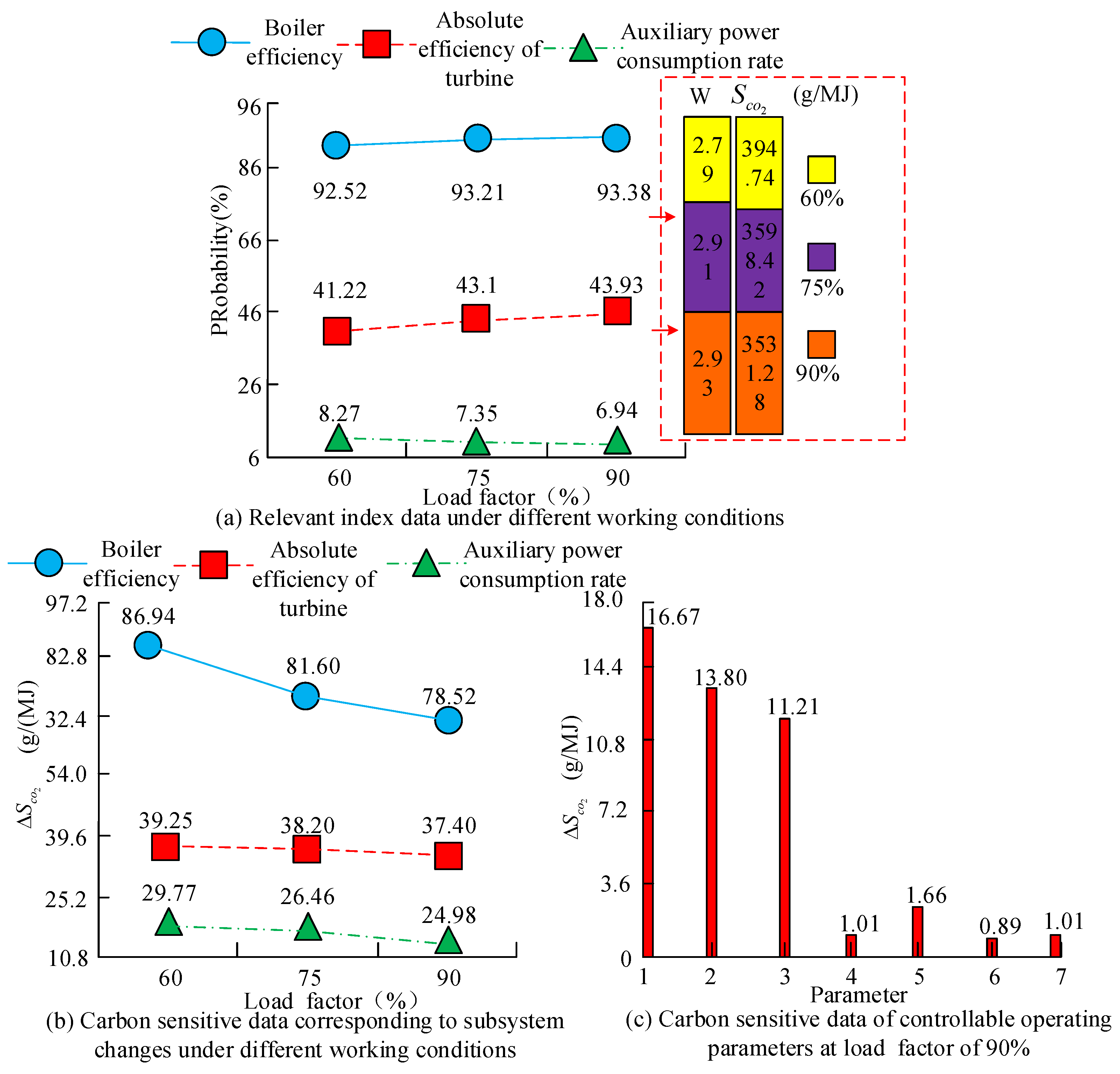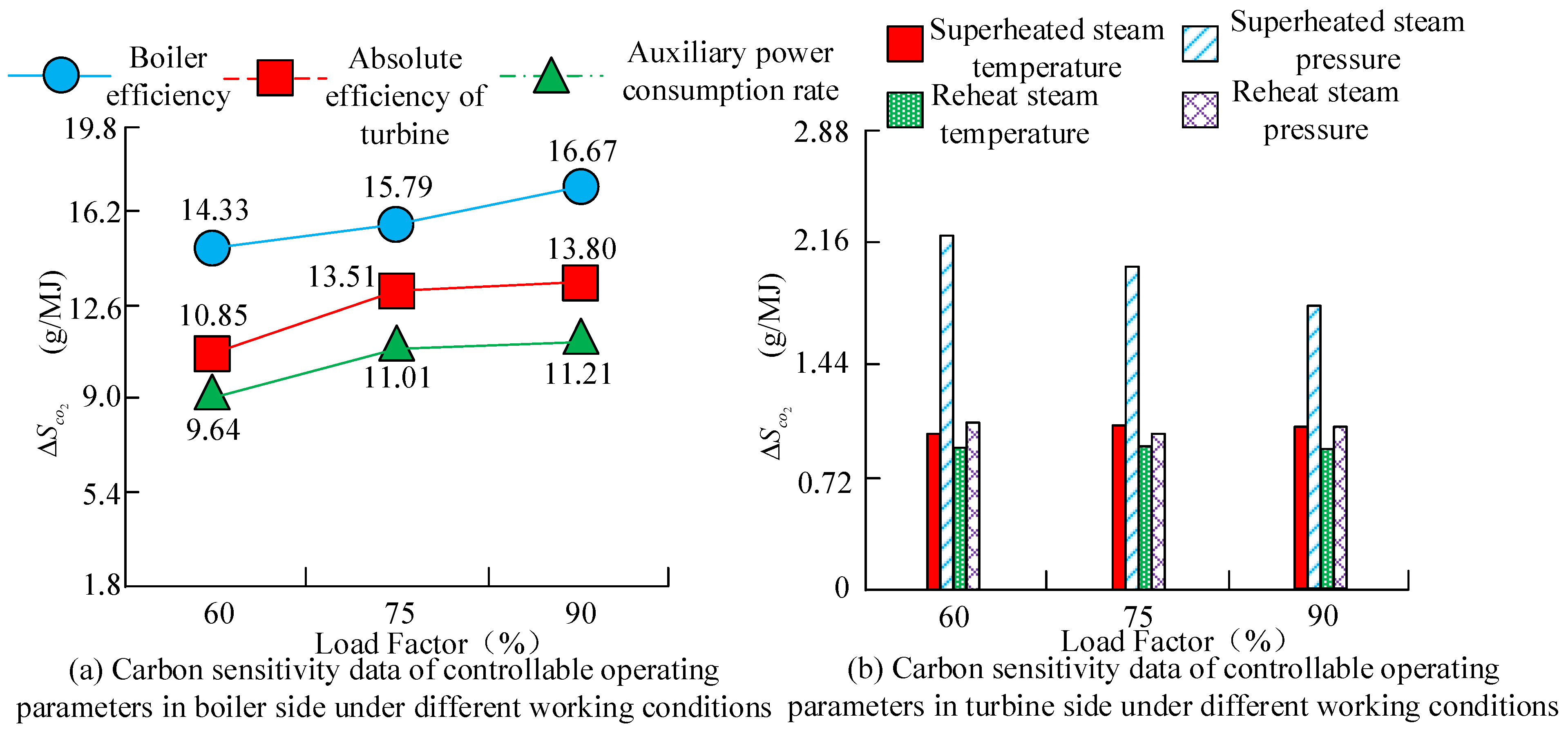Analysis of Carbon Emissions and Emission Reduction from Coal-Fired Power Plants Based on Dual Carbon Targets
Abstract
:1. Introduction
2. Literature Review
3. Carbon Emission Calculation Model Construction for Coal-Fired Power Plants
3.1. Calculation of Sensitivity Analysis of Carbon Emission Parameters
3.2. Carbon Emissions Data Accounting Model
4. Example Data Calculation and Carbon Reduction Analysis
4.1. Sensitivity Analysis of Controllable Operating Parameters for Coal-Fired Power Supply Carbon Emissions
4.2. Calculation of Coal Combustion Emission Factors
4.3. Calculation of Carbon Emissions from Coal Combustion
4.4. Carbon Reduction Analysis
5. Conclusions
Author Contributions
Funding
Institutional Review Board Statement
Informed Consent Statement
Data Availability Statement
Conflicts of Interest
Glossary
| Name | International Units |
| Carbon emission intensity | kgCO2/IntGK $ |
| Temperature | K |
| Volume | m3 |
| Specific heat capacity | J/(kg·K) |
| Quantity of heat | J |
| Absolute humidity | g/m3 |
| Calorific value | MJ |
References
- Yu, G.; Hao, T.; Zhu, J. Discussion on action strategies of China’s carbon peak and carbon neutrality. Bull. Chin. Acad. Sci. Chin. Version 2022, 37, 423–434. [Google Scholar] [CrossRef]
- Jiang, T.; Yu, Y.; Yang, B. Understanding the carbon emissions status and emissions reduction effect of China’s transportation industry: Dual perspectives of the early and late stages of the economic “new normal”. Environ. Sci. Pollut. Res. 2022, 29, 28661–28674. [Google Scholar] [CrossRef]
- Mao, X.; Wang, Y. Cooperative carbon emission reduction through the belt and road initiative. Environ. Sci. Pollut. Res. 2022, 29, 10005–10026. [Google Scholar] [CrossRef] [PubMed]
- An, Y.; Zhou, D.; Wang, Q. Carbon emission reduction potential and its influencing factors in China’s coal-fired power industry: A cost optimization and decomposition analysis. Environ. Dev. Sustain. 2022, 24, 3619–3639. [Google Scholar] [CrossRef]
- Xue, X.; Wang, Y.; Chen, H.; Xu, G. A coal-fired power plant integrated with biomass co-firing and CO2 capture for zero carbon emission. Front. Energy 2022, 16, 307–320. [Google Scholar] [CrossRef]
- Cabernard, L.; Pfister, S.; Oberschelp, C.; Hellweg, S. Growing environmental footprint of plastics driven by coal combustion. Nat. Sustain. 2022, 5, 139–148. [Google Scholar] [CrossRef]
- Guo, Q.; Xi, X.; Yang, S.; Cai, M. Technology strategies to achieve carbon peak and carbon neutrality for China’s metal mines. Int. J. Miner. Metall. Mater. 2022, 29, 626–634. [Google Scholar] [CrossRef]
- Khan, H.; Weili, L.; Khan, I. The role of institutional quality in FDI inflows and carbon emission reduction: Evidence from the global developing and belt road initiative countries. Environ. Sci. Pollut. Res. 2022, 29, 30594–30621. [Google Scholar] [CrossRef]
- Kou, P.; Han, Y.; Qi, X.; Li, Y. Does China’s policy of carbon emission trading deliver sulfur dioxide reduction co-benefits? Environ. Dev. Sustain. 2022, 24, 6224–6245. [Google Scholar] [CrossRef]
- Ansari, M.A.; Akram, V.; Haider, S. A link between productivity, globalisation and carbon emissions: Evidence from emissions by coal, oil and gas. Environ. Sci. Pollut. Res. 2022, 29, 33826–33843. [Google Scholar] [CrossRef]
- Dong, F.; Zhu, J.; Li, Y.; Chen, Y.; Gao, Y.; Hu, M.; Sun, J. How green technology innovation affects carbon emission efficiency: Evidence from developed countries proposing carbon neutrality targets. Environ. Sci. Pollut. Res. 2022, 29, 35780–35799. [Google Scholar] [CrossRef] [PubMed]
- Mo, J.Y. Technological innovation and its impact on carbon emissions: Evidence from Korea manufacturing firms participating emission trading scheme. Technol. Anal. Strat. Manag. 2022, 34, 47–57. [Google Scholar] [CrossRef]
- Cui, R.Y.; Hultman, N.; Cui, D.Y.; Mcjeon, H.; Clarke, L.; Yuan, J.H.; Cai, W.J. A US–China coal power transition and the global 1.5 °C pathway. Adv. Clim. Chang. Res. 2022, 13, 179–186. [Google Scholar] [CrossRef]
- Wu, J.; Cui, C.; Guo, X. Impacts of the West–East Gas Pipeline Project on energy conservation and emission reduction: Empirical evidence from Hubei province in central China. Environ. Sci. Pollut. Res. 2022, 29, 28149–28165. [Google Scholar] [CrossRef]
- Jiang, T.; Li, S.; Yu, Y.; Peng, Y. Energy-related carbon emissions and structural emissions reduction of China’s construction industry: The perspective of input–output analysis. Environ. Sci. Pollut. Res. 2022, 29, 39515–39527. [Google Scholar] [CrossRef]
- Jia, K. Goals on the road: Institutional innovations in carbon peak and carbon neutrality. J. Chin. Econ. Bus. Stud. 2022, 20, 95–107. [Google Scholar] [CrossRef]
- Gao, G.; Zhang, M.; Wang, S.; Wang, C.; Zhang, R. Assessment of pollutant emissions reduction potential of energy infrastructure in industrial parks of Henan Province.Environ. Develop. Sustainability 2022, 24, 8071–8091. [Google Scholar] [CrossRef]
- Yang, H.; Gan, T.; Liang, W.; Liao, X. Can policies aimed at reducing carbon dioxide emissions help mitigate haze pollution? An empirical analysis of the emissions trading system. Environ. Dev. Sustain. 2022, 24, 1959–1980. [Google Scholar] [CrossRef]
- Ryabov, G.A. Cofiring of coal and fossil fuels is a way to decarbonization of heat and electricity generation. Therm. Eng. 2022, 69, 405–417. [Google Scholar] [CrossRef]
- Booth, M.S. “Sustainable” biomass: A paper tiger when it comes to reducing carbon emissions. Bull. At. Sci. 2022, 78, 139–147. [Google Scholar] [CrossRef]
- Yang, B.; Bai, Z.; Wang, J. Spatiotemporal dynamic differences of energy-related CO 2 emissions and the related driven factors in six regions of China during two decades. Environ. Sci. Pollut. Res. 2022, 29, 24737–24756. [Google Scholar] [CrossRef]
- Li, J.; Wang, T.; Liu, P.; Li, Z. Dynamic modelling and simulation of a post-combustion CO 2 capture process for coal-fired power plants. Front. Chem. Sci. Eng. 2022, 16, 198–209. [Google Scholar] [CrossRef]
- Raza, M.A.; Khatri, K.L.; Memon, M.A.; Rafique, K.; Haque MI, U.; Mirjat, N.H. Exploitation of Thar coal field for power generation in Pakistan: A way forward to sustainable energy future. Energy Explor. Exploit. 2022, 40, 1173–1196. [Google Scholar] [CrossRef]
- Zhang, Y.; Yu, Z.; Zhang, J. Research on carbon emission differences decomposition and spatial heterogeneity pattern of China’s eight economic regions. Environ. Sci. Pollut. Res. 2022, 29, 29976–29992. [Google Scholar] [CrossRef]
- Zhang, Y.; Xu, X. Carbon emission efficiency measurement and influencing factor analysis of nine provinces in the Yellow River basin: Based on SBM-DDF model and Tobit-CCD model. Environ. Sci. Pollut. Res. 2022, 29, 33263–33280. [Google Scholar] [CrossRef]
- Jiang, L.; Sakhare, S.R.; Kaur, M. Impact of industrial 40 on environment along with correlation between economic growth carbon emissions. Int. J. Syst. Assur. Eng. Manag. 2022, 13, 415–423. [Google Scholar] [CrossRef]
- Wang, Q.; Dong, Z. Technological innovation and renewable energy consumption: A middle path for trading off financial risk and carbon emissions. Environ. Sci. Pollut. Res. 2022, 29, 33046–33062. [Google Scholar] [CrossRef]
- Kirikkaleli, D.; Güngör, H.; Adebayo, T.S. Consumption-based carbon emissions, renewable energy consumption, financial development and economic growth in Chile. Bus. Strat. Environ. 2022, 31, 1123–1137. [Google Scholar] [CrossRef]
- He, S.; Gao, L.; Dong, R.; Li, S. A novel hydrogen production system based on the three-step coal gasification technology thermally coupled with the chemical looping combustion process. Int. J. Hydrogen Energy 2022, 47, 7100–7112. [Google Scholar] [CrossRef]
- Zhan, X.; Xu, H.; Zhang, Y.; Zhu, X.; Yin, H.; Zheng, Y. Deepthermal: Combustion optimization for thermal power generating units using offline reinforcement learning. Proc. Conf. AAAI Artif. Intell. 2022, 36, 4680–4688. [Google Scholar] [CrossRef]
- Previti, S.; Di Chio, C.; Ettari, R.; Zappalà, M. Dual inhibition of parasitic targets: A valuable strategy to treat malaria and neglected tropical diseases. Curr. Med. Chem. 2022, 29, 2952–2978. [Google Scholar] [CrossRef] [PubMed]
- Zhang, X.; Dou, Y.; Zhang, C.; Ding, L.; Lv, H. Carbon emission management of coal power plant from the perspective of production planning in China. J. Ind. Prod. Eng. 2023, 40, 22–34. [Google Scholar] [CrossRef]
- Lee, C.C.; Hussain, J. Optimal behavior of environmental regulations to reduce carbon emissions: A simulation-based dual green gaming model. Environ. Sci. Pollut. Res. 2022, 29, 56037–56054. [Google Scholar] [CrossRef]
- Müller, L.; Ramires, P.F.; dos Santos, M.; Coronas, M.V.; Lima, J.V.; Dias, D.; da Silva Júnior, F.M.R. Human health risk assessment of arsenic in a region influenced by a large coal-fired power plant. Int. J. Environ. Sci. Technol. 2021, 19, 281–288. [Google Scholar] [CrossRef]
- Debnath, R.; Mittal, V.; Jindal, A. A review of challenges from increasing renewable generation in the Indian Power Sector: Way forward for Electricity (Amendment) Bill 2020. Energy Environ. 2021, 33, 3–40. [Google Scholar] [CrossRef]
- Panchal, D.; Chatterjee, P.; Pamucar, D.; Yazdani, M. A novel fuzzy-based structured framework for sustainable operation and environmental friendly production in coal-fired power industry. Int. J. Intell. Syst. 2022, 37, 2706–2738. [Google Scholar] [CrossRef]
- Raheem, A.T.; Aziz, A.R.A.; Zulkifli, S.A.; Baharom, M.B.; Rahem, A.T.; Ayandotun, W.B. Optimisation of operating parameters on the performance characteristics of a free piston engine linear generator fuelled by CNG–H2 blends using the response surface methodology (RSM). Int. J. Hydrogen Energy 2021, 47, 1996–2016. [Google Scholar] [CrossRef]
- Baidya, D.; de Brito, M.A.R.; Sasmito, A.P.; Ghoreishi-Madiseh, S.A. Diesel generator exhaust heat recovery fully-coupled with intake air heating for off-grid mining operations: An experimental, numerical and analytical evaluation. Int. J. Min. Sci. Technol. 2022, 32, 155–169. [Google Scholar] [CrossRef]
- Wirtz, M.; Stutz, B.; Phan, H.T.; Boudehenn, F. Numerical modeling of falling-film plate generator and rectifier designed for NH3—H2O absorption machines. Heat Mass Transf. 2021, 58, 431–446. [Google Scholar] [CrossRef]
- Yang, F.; Jia, L.; Zhou, Y.; Guan, D.; Feng, K.; Choi, Y.; Li, J. Life cycle assessment shows that retrofitting coal-fired power plants with fuel cells will substantially reduce greenhouse gas emissions. One Earth 2022, 5, 392–402. [Google Scholar] [CrossRef]
- Han, L.; Zhao, Y.; Hao, R. Arsenic emission and distribution characteristics in the ultra-low emission coal-fired power plant. Environ. Sci. Pollut. Res. 2022, 29, 36814–36823. [Google Scholar] [CrossRef] [PubMed]
- He, F.; Liu, X.; Wang, M.; Zhou, S.; Heydarian, D. Energy, exergy, exergoeconomic, and environmental analyses and multi-objective optimization of a biomass-to-energy integrated thermal power plant. Alex. Eng. J. 2022, 61, 5629–5648. [Google Scholar] [CrossRef]







| Particular Year | 2018 | 2019 | 2020 | 2021 |
|---|---|---|---|---|
| Annual average carbon content per unit calorific value of coal (t/TJ) | 26.3 | 27.8 | 28.1 | 28.2 |
| Annual production of boiler residue/t | 3548.5 | 2686.7 | 2248.2 | 2548.1 |
| The average carbon content level of residue in the boiler/% | 0.8 | 0.5 | 1.1 | 1.2 |
| Annual fly ash production/t | 31,936.3 | 24,181.1 | 20,234.0 | 22,931.4 |
| Average carbon content of fly ash/% | 0.4 | 0.5 | 0.9 | 1.0 |
| Efficiency of dust collectors/% | 99.9 | 99.9 | 99.9 | 99.9 |
| Probability of oxidation of coal carbon during combustion/% | 99.6 | 99.8 | 99.7 | 99.5 |
| Particular Year | 2018 | 2019 | 2020 | 2021 |
|---|---|---|---|---|
| Annual average low calorific value of raw coal (kJ/kg−1) | 16,500 | 17,501 | 18,059 | 17,972 |
| Average annual carbon oxidation rate of coal combustion (%) | 99.108 | 99.115 | 98.916 | 98.514 |
| Annual consumption of raw coal (t) | 1,757,100 | 1,713,170 | 1,756,620 | 2,062,479 |
| Annual average carbon content per unit calorific value of coal (tC/GJ−1) | 0.026 | 0.025 | 0.027 | 0.028 |
| Carbon dioxide emissions from coal-fired combustion (t) | 2,830,149 | 2,920,996 | 3,102,600 | 3,641,598 |
| Particular Year | 2018 | 2019 | 2020 | 2021 |
|---|---|---|---|---|
| Low calorific value of raw coal Grandma General (kJ/kg) | 16,560 | 17,710 | 18,100 | 18,260 |
| Average annual carbon oxidation rate of coal combustion (%) | 99.000 | 98.870 | 99.065 | 98.869 |
| Annual consumption of raw coal (t) | 2,097,960 | 1,850,813 | 1,986,599 | 1,595,100 |
| Annual average carbon content per unit calorific value of coal (tC/GJ) | 0.026 | 0.025 | 0.027 | 0.028 |
| CO2 emissions from coal combustion (t) | 3,387,300 | 3,181,330 | 3,525,659 | 2,867,789 |
Disclaimer/Publisher’s Note: The statements, opinions and data contained in all publications are solely those of the individual author(s) and contributor(s) and not of MDPI and/or the editor(s). MDPI and/or the editor(s) disclaim responsibility for any injury to people or property resulting from any ideas, methods, instructions or products referred to in the content. |
© 2023 by the authors. Licensee MDPI, Basel, Switzerland. This article is an open access article distributed under the terms and conditions of the Creative Commons Attribution (CC BY) license (https://creativecommons.org/licenses/by/4.0/).
Share and Cite
Hou, H.; Xie, B.; Cheng, Y. Analysis of Carbon Emissions and Emission Reduction from Coal-Fired Power Plants Based on Dual Carbon Targets. Sustainability 2023, 15, 7369. https://doi.org/10.3390/su15097369
Hou H, Xie B, Cheng Y. Analysis of Carbon Emissions and Emission Reduction from Coal-Fired Power Plants Based on Dual Carbon Targets. Sustainability. 2023; 15(9):7369. https://doi.org/10.3390/su15097369
Chicago/Turabian StyleHou, Haitao, Bo Xie, and Yingying Cheng. 2023. "Analysis of Carbon Emissions and Emission Reduction from Coal-Fired Power Plants Based on Dual Carbon Targets" Sustainability 15, no. 9: 7369. https://doi.org/10.3390/su15097369
APA StyleHou, H., Xie, B., & Cheng, Y. (2023). Analysis of Carbon Emissions and Emission Reduction from Coal-Fired Power Plants Based on Dual Carbon Targets. Sustainability, 15(9), 7369. https://doi.org/10.3390/su15097369






